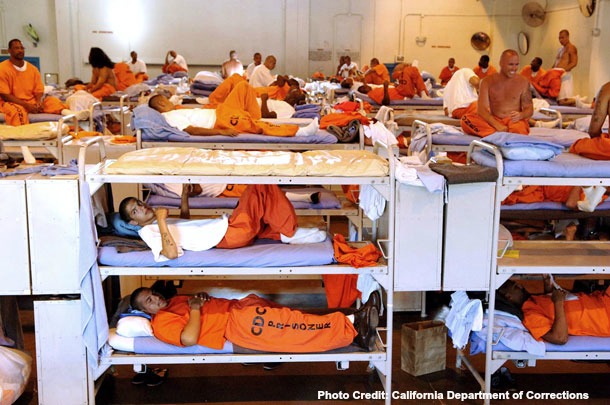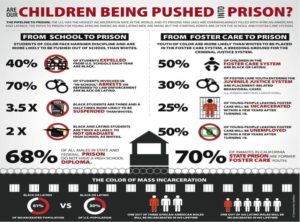Have you noticed how so many of our Latino youth end up in prison, or in “youth camps”? This is known as the School to Prison Pipeline and a report released this month by the Department of Education has made it very clear that it’s not just your imagination. While spending for prisons has tripled since the late ‘70s, the growth of spending on education has declined. The United States now has 2.5 million people in prison, compared to 300,000 in the early ‘80s. Maybe you have heard about the School to prison pipeline, but in case you haven’t, it refers to the policies and practices that push our nation’s schoolchildren, especially our most at-risk children, out of classrooms and into the juvenile and criminal justice systems. Well both Latinos and African American Kids have been the most affected. And the policies which which created this have to be reversed.
The issue mass incarceration of Latinos in our community is not discussed and it’s not talked about enough in the media. It’s also surprising that although mass incarceration affects Latinos at much higher numbers than whites, most Latino leaders or elected officials have not spoken out against the conditions and policies that send one out of every six Latinos to prison. So, isn’t it time for mothers to demand justice — for Latina moms and abuelitas to say, “Basta!”
Our leaders have failed to take a bold action to protect our kids, and even Democrats, who we overwhelmingly reward with our votes, have not spoken out forcefully enough on this issue. We should yell as loud as the church bells, “You can’t take my sons or daughters to fill up your prisons, jails, and juvenile camps any longer!” This facade of being tough on crime with useless crime bills, has helped to get elected officials re-elected. Politicians know that people like to feel safe and have sold these ineffective laws to us with the premise that they will protect us. Thus, over the years, it’s our elected officials who have created tough on crime policies in schools and in our communities that have lead to a demand for prison growth and have locked up our Latino youth. First Richard Nixon in the 1970’s created the War on Drugs, which taught the politicos how useful this tool of selling a veil of safety was to get elected. This tactic was then used by Bill Clinton and he made promises in his campaign to get tough on crime. As such, he passed the 1994 crime bill which had the provisions for three strikes law that has truly been the nail on the hammer to our youth. This bill provided billions of dollars across the Nation to build prisons, juvenile camps and to the fill prisons. Every state passed their own Three Strikes Law and fought for money to build more prisons. It became an economic development tool for a select few to get rich, rather than a tool to keep crime off the streets. It is now well known that sending our non violent criminals to prison does not reduce crime, in fact it hardens the non violent offenders, which worsens crime in the long run and it breaks apart families Crime-Bill. This is an outrage and a crisis in our communities.
We no longer lack information on the results of the Crime Bill or the War on Drugs, and we can prove that we aren’t imagining that too many Latinos from our communities are ending up in prison. The Federal Bureau of Justice has numbers indicating that Latino men were incarcerated at a rate nearly 40% higher than whites (1,822 per 100,000 compared to 708 per 100,000) as of 2012. In all, one in three persons held in federal prisons is Latino, and Latinos are four times as likely as whites to end up in prison.
Also, in California, Latinos were overrepresented in drug arrests in all cities within Los Angeles and Orange County, along with fifteen other major cities. Let’s look at Alhambra, a city in Los Angeles County with a population of 85,949, Latinos made up only 35.5% of the population, but made up 74.6% of marijuana arrests in the city. Nationwide information isn’t very consistent on Latinos. In government data, we are either labelled Hispanic or white (even though we aren’t treated as such), so many details about Latinos, many of whom are indigenous and even African in origin, are lost.
This is a crisis for Latino communities because mass incarceration breaks apart our families, reduces our wealth building potential, hinders our ability to graduate from high school and pursue post-secondary education, and it dampens our potential to succeed as a community. One-sixth of our male population in prison across the nation, and still many fathers, mothers, sisters and brothers are trapped in immigrant detention centers. Immigrant detention is a huge part of our incarceration problem and needs to be viewed as such in the public debates about incarceration and immigration that are happening in the election year discourse. Both Incarceration and Immigrant Detention break apart families in the same way and create the same negative results.
To make it even more clear, here is an infographic created by the Community Coalition that gives a great visual of the effects of the school to prison pipeline. The graphic shows that Latinos are twice as likely to not graduate as their white counterparts. It also indicates that 68% of the men in prison don’t have a high school diploma, and 70% of the state inmates are former foster care youth. If our families are torn apart by incarceration and immigration policies that will send even more of our youth to foster care, this could be setting them up for a future in prison. If our kids don’t graduate from high school or are forced into foster care when they are separated from their parents, who end up getting locked up, these children are likely to suffer similar fate.
Let’s ask ourselves the hard questions and demand action and justice from our elected leaders. As mothers, parents, guardians, tías, ninas and community leaders we should ask, “Who is benefiting from this mass incarceration of our sons and daughters? Who is getting rich? Has the war on drugs and the war on crime helped us at all, or has it hurt us over the years?” Even Bill Clinton, the president that was responsible for the 1994 Crime Bill has admitted his mistake in an interview with CNN and said, “we wound up … putting so many people in prison that there wasn’t enough money left to educate them, train them for new jobs and increase the chances when they came out so they could live productive lives.” Well, if President Bill Clinton admits this was a mistake, let’s get to work and turn it around.
It’s time to demand change starting with our Latino leaders, principals, school board members, and superintendents. Let them know that this overspending on prisons must end. If we want more funding for schools, our teachers, and programs for our kids, we must be united in advocating an end to mass incarceration. Basta con esta locura!
Marta A. Segura, M.P.H.
Her network is vast as she has been working across sectors for over 20 years. Her passion for civic engagement knows no boundaries. Marta has more than 20 years of management, leadership and advocacy experience in the public and nonprofit sectors, and served as District Director for then Councilmember Eric Garcetti, now Mayor of Los Angeles. Marta has an uncanny ability to integrate both her leadership and people skills into all that she does. Also she is an advocate for Open Space, Toxic Free Communities, and is passionate about building the wellbeing and voices of our most marginalized communities. Her recent clients have included Nike, LA 84 Foundation, LA SAN, City of LA, Housing Authority of the City of LA, and the Los Angeles Latino Chamber of Commerce.
She graduated from public schools in San Jose, California and from there she went to UCSB for her bachelor’s degree and then later received her Master’s Degree from UCLA’s School of Public Health. Marta wanted her son to also to attend public schools, but she transferred him out in the 3rd grade, because the school system was in decline in her neighborhood, and she made the very difficult choice of transferring him to a Catholic School in South LA, where he has thrived free of bullying and has been inspired to learn every day.
Latest posts by Marta A. Segura, M.P.H. (see all)
- ¿Creen Los Maestros en Nuestros Estudiantes? - October 24, 2016
- Do Teachers Believe in our Students? - October 24, 2016
- Demanding Toxic Free Zones and Safer School and Play Areas for our Kids - July 20, 2016
- Exigir Zonas Libres de Tóxicos y Escuelas con Áreas de Juego más Seguras para Nuestros Estudiantes - July 20, 2016
- Latino Youth, Mass Incarceration and Education - July 12, 2016



Pingback: Latino Youth Imprisoned – Unheard Voices